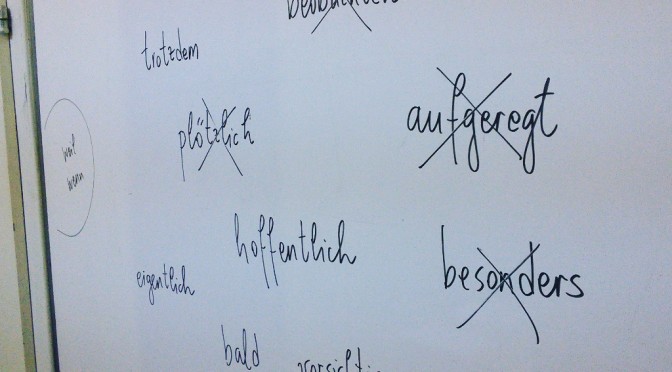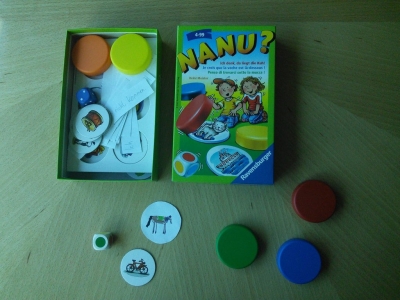After they explain word meanings, good teachers ask themselves ‘Now, how can I actually teach my students these new words’?
Well, that is exactly the question that I was asking myself over and over again. It took some time before I ‘trained’ myself on how this can be done and how it works. Here are my foundings that I would like to share:
- NANU
This game is very popular among kids. They just love it! It works like a memory game, it’s just more interesting. There are 5 little plastic lids in different colours (red, blue, green, yellow, orange) and a number of little round cards with pictures on them. The pictures are in the same size as the lids so that you can cover them with lids. The point is to remember which picture is under which lid. Each player throws a dice (with 5 colours and a joker on its sides) in turn and should guess what is under the lid in the colour he/she got (if they can remember). There are several cards in the game itself, but you can draw yourself as many pictures as you ever might need. You can order your ‘Nanu?’ here.
2. BUCHSTABENSALAT (letter salad) – pick the words that you would like for your students to learn and change the letter order completely and ask them to guess what is the word in question. For example: you take the Verb ‘weinen’ and combine its letter into something like this: ‘ewinne’. This way the students learn to write the word in question and familiarize themselves with the completely new word.
3. ADD AN EXTRA LETTER into a word (the shorter the word the better) that you want to familiarize your students with and insert one extra letter into that word. Ask the students to recognize which word you are looking for. Just make sure that you give them a variation that won’t be too easy for them to recognize. For example: you are looking for the word ‘toll’ and you give them ‘troll’.
4. WORD GRID – gather words that you would like to go through and put them in a grid with various different letters. Ask of students to find words in the grid (you can even specify which words exactly you expect them to find). In order to generate this exercise I recommend that you use ‘word grid’ option in the LearningApps application. Click here to find out how you can create your own word grid and other exercises.
5. LÜCKENTEXT (close test) – This is also a very good way to give your students the opportunity to familiarize themselves with completely new words. The most important advice here is “keep it simple”, in other words, make sure that you put the new words in a known context. You could even use the same (or slightly different) sentences as in the new text. There are generators that can help you create this sort of exercises. Click here to find out how you can create your own exercises.
6. VOKABELHEFT / QUIZLET – have the students write the word down in their vocabulary book or they can use Quizlet with the same purpose. This is a free application that can replace the old fashion vocabulary book. Its best advantage is that students can download it and use it on their smart phones which means that they could learn and repeat words and phrases anywhere. I find it very useful that students can create their own study sets and play with the flash cards they have created themselves and hear the word pronunciation at the same time. Quizlet can be downloaded here. Check out other useful applications.
When you are repeating words with your students, you can use the following:
-
- BRAINSTORMING – can be used before you start with a new text or lesson. Sometimes we forgot this good old fashioned way of knowledge activating. It could go like this: you write a word on the whiteboard and the learners say everything that comes to their mind: words, phrases, sentences. Check out how you can create a beautiful word clouds out of words that you collect during the brain storming.
- PICTURES – You can use pictures and ask the students to describe them. Click here to check out pictures that I show to my students.
- SEMANTISIERUNG – I don’t know what is the English word for this, but the point is clear – when explaining new/unknown words, do it with already known words in that foreign language.
- GALGENMÄNNCHEN (hang man) – this is a good start of the class. Something to warm the students up. You can draw the game on the white board in the class room or you can create your own online application. The advantage of the application is that you can use as many words as you like and as often as you wish. Click here in order to create learningapps (number 6).
-
- STILLE POST (telephone game) – this is a well known game and it’s fun! One learner whispers a word to the learner next to them and so on. The last person in the row says the word out loud. It is interesting to see how the word will sound in the end.
- MULTIPLE CHOICES QUIZ – people aged 7 – 77 love this type of exercise. Click here in order to find use a multiple-choice quiz generators (numbers 2 or 6).
- TRANSLATE A SENTENCE INTO GERMAN – this is quite self explanatory. Of course, the students need to translate a sentence from their mother tongue into German.
- VOKABELBINGO – give the students a blank sheet of paper with a 5×5 table on it – that will be their bingo cards. They should write the words on them which will end up with various word combinations – you do not even have to give them tables filled with words – they can do that themselves. Of course, you tell them which (24) words they should use. If you wish an easier version you can leave blank one field in the middle of the 5×5 table. Prepare the words before the class and write them on little pieces of paper which will then be drawn until someone yells ‘bingo’! (there can be more than one winner if you continue the game after the first ‘bingo’). You can use a bingo cards generator (which will produce cards with words on them) if you prefer it that way – click here in order to find more explanation (number 5). During the game you can ask learners which words they need until their first/second/third bingo.
- VOKABELLOTTO – you can play lotto with your students too – the principle is almost the same as with Bingo (see above). The students can write the words themselves (you don’t have to do that instead of them, but you can if you wish), you need cards with 4×7 fields and tell the students which 29 words they should use. They write their words on cards in the way they like and then tick 9 words of their choice. When they are done, you draw 9 words out of the 29 words (which you have prepared and written on little pieces of paper before the class)- the winner is the student that has the best score.
- PANTOMIME – this is quite self-explanatory. You just need to choose words that can be explained with pantomime. Each student draws the word that they should show in front of others. This can be tricky if your students are shy.
- FIND THE WORD THAT DOES NOT BELONG TO THE ROW (Was passt nicht?) – this is the exercise that is well known. One of the given words does not belong to the row. For example: Tisch – Stuhl – Blume – Schrank (Blume doesn’t belong to this row).
- ANTONYMES – this is self-explanatory: find at least 5 antonyms, for example: gut-schlecht; lang-kurz; leise-laut, and and give your students only one part of the pair (gut, lang, leise), their task is to complete the pair.
- FOTO RALLEY – everybody has a phone with good camera, thus, you don’t need any special equipment. You can change the difficulty level of these tasks: you can either have your students make photos of things that they use on a daily basis or you can shoot a photo story with them.
- WRITE A SIMPLE POEM – there are some simple rules for this exercise. Students need to write a poem which should contain 5 rows. The 1. row should contain only 1 word; the 2. row should contain 2 words and show “what the word in the 1. row means”; 3. row should contain 3 words which should describe “what the first word does or is”; 4. row should contain 4 words and should start with “ich”; the last row should again contain only 1 word as an end. This could look like and sound this (an example from one of my classes): Warten. Ist lang. Wann kommst du? Ich komme sehr bald. Wunderbar.
- SEEMANSGARN SPINNEN – this is a great exercise if you wish to have your students speak freely in the foreign language. They just love it and believe me they will be grateful. Prepare words (at least 10) before the class, write them on the white board when you come in the class, think of one sentence with which the story is going to start and have the students think of a new sentence using one of the given words. They should speak in row and continue the story until all words from the white board are used.
- DOOBLE CARDS – you can make cards out of words that your students are learning and have your students play those cards. For more information click here (number 4).
- SCHNITZELJAGD – work in progress.
- CREATE AS MANY AS POSSIBLE WORDS OF GIVEN WORDS – for example “Deutschland” and “Demokratie”. For more information click here.
- STATIONEN-LERNEN – work in progress.
- MORE COMPLEX TASKS – Interviews: write questions on papers and all students interwiev each other and mark answers down. At the end you “collect” all answers and tell a “story” about everybody.
- PING-PONG STORY – your students can use Skype, Viber or any other texting tool that could help them write sentences in pairs. They could for example describe a photo that stands in front of them – working in pairs and writing one sentence each in turn or describe one day in the life of their iPhone.






